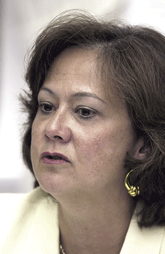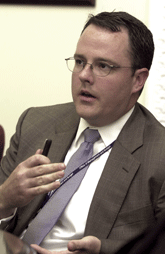For President Bush, effective implementation of e-government is critical to making government more responsive and cost-effective. Its success, he says, depends on agencies working as a team across traditional boundaries, focusing on citizens rather than individual agency needs.The Office of Management and Budget's E-government initiatives are the most visible manifestation of the government's cross-agency efforts. Karen Evans, OMB administrator for e-government and IT, and OMB's five e-government portfolio managers talked about those efforts in a recent interview with GCN staff writer Jason Miller and associate editor Richard W. Walker. [IMGCAP(2)]On hand were portfolio managers Shivani Desai, government to business; Jack Koller, government to citizen; Jeanette Thornton, e-authentication; Tim Young, internal efficiency and effectiveness; and Kamela White, government to government.THORNTON: We have definitely seen it get a lot easier for the past couple of years. When we first started this, people didn't have a good sense of what it would be like to develop IT solutions across an agency. Lots of times, they were just challenged implementing an IT system within their own agency or among many different bureaus within an agency. People really better understand challenges and how to better work across agency boundaries, which is no easy thing in itself.THORNTON: We've learned how to put in place governance structures that bring together agency partners so all have a voice in the decisions and direction of the initiative. We've learned how to better communicate with the agencies so information is shared not just between the managing partner and OMB, but also with the partners, which is a very important thing. Partners need to know that their money is being spent toward the thing they want it to be spent for.WHITE: In the beginning we had these great ideas of how we can better leverage across the federal government and try to break down stovepipes across common business functions, which a number of e-government initiatives represented. So that action, which brings us performance improvements and efficiencies, helps to chip away those cultural challenges in agencies because they are realizing there are benefits from the initiatives.EVANS: Now what we are getting into is the part of the challenge that you always have to deal with in a change management type of project. We have to deal with the people issues on a daily basis. We cannot communicate enough. We can't have a lack of transparency. We need a lot of clarity and a lot of visibility into everything we are doing. Not just for the managing partners, but for Congress and the taxpayer as well so they know what we are doing. Communication has been the challenge, continues to be the challenge and will always be a challenge because we have to make sure everybody knows what we are doing.EVANS: I don't know if things have gotten more difficult, but I would come back to communication. We have to communicate at multiple levels. Initially, it was getting buy-in at a certain level within an agency. This isn't just about e-government, but the President's Management Agenda overall. For the first three years of the PMA, it has been very focused at the high levels of the organization. Now we are taking the PMA and driving it down further into the agencies so that the career employees in the field can see exactly where they fit in and why we are doing these things, and what the PMA means to them.KOLLER: Almost every employee has been affected by e-government. E-Payroll, for example: In one sense, the victory of that project was that the employees didn't see any incremental change of their daily operations in how they see their paycheck.YOUNG: What I try to do is individualize the impact on the average federal employee. The average cost to process a W-2 went down by implementing E-Payroll. That is in the best interest of that taxpayer, who also is a federal employee. In addition to that, E-Training demonstrated you can increase service offerings to federal employees without drastically impacting that agency's funding commitment to it'more for less.[IMGCAP(3)]EVANS: The initiatives have to show meaning to the career workforce. They are not going to get done without the career workforce. They are not going to become institutionalized without the career workforce. And [the people who make up the] career workforce are the ones that do the day-in and day-out work; they serve many administrations; they are about the programs and what they can achieve.THORNTON: It is important, too, that a lot of the initiatives have really worked with internal and external customers to develop a solution that is a process improvement, and it makes their job a lot easier than before.EVANS: We have to clearly demonstrate to each of the agencies what they will achieve for their investment. The way we are doing this is no different than if you were in private industry. We are asking agencies to invest dollars into a common solution, and they have to see what benefits they get in return help support their mission. It is a challenge, but there are tools available for us to use in order to be able to succeed, provided that we are making a good business case and clearly demonstrate to the agencies what results they will achieve from that.THORNTON: There are many things we can use, such as having all the partners approve the business case before it is submitted to OMB. They can sign off on where their funds are being used, and that really adds to the accountability of the initiative. I know with E-Authentication we entered the process of developing a very detailed funding plan that documented how each one of the partner dollars will be spent, what quarter it will be spent in, and what specific task and performance goal it will achieve. All these partners had to vote and provide comments before spending partners' money.KOLLER: One of the exciting things to see in my portfolio is the innovation each managing partner agency has brought into trying to direct their present and future funding plans. In the five initiatives in my portfolio, I don't see any two that are alike. Two have direct appropriations, some of them use recovery service fees because they are a public-facing site, and some are directly appropriated but have additional dollars from agency contributions.Innovation really lies within the agencies, not OMB, and they have really run with this.WHITE: We also have the Economy Act, which includes a lot of common-sense language to help us get rid of redundant investments. OMB is working with federal agencies through the Federal Enterprise Architecture, and through agency budget investments we can identify redundancies, whether related to e-government initiatives or other business functions. OMB can work with the agencies to redirect funding and take the appropriate steps to eliminate unnecessary, wasteful spending.EVANS: We have the Economy Act, the E-Government Act, Clinger-Cohen Act and the Federal Information Security Management Act. So, with all that statutory authority we have the ability to focus on the best governmentwide solution for the service we are looking at. So we look at the FEA as people send their business cases in. There are lots of tools for us to work with agencies on what have been classified as funding issues.[IMGCAP(4)]DESAI: In my portfolio, we have funding work groups within the initiatives to come up with the fair formula that makes sense and it is not pushed from the top. Agencies know it is a business process we contribute to; it is mission-critical to our agency, and when we are coming together to do it as a governmentwide project, agencies need to figure out how fair they feel it is.EVANS: It is always better to be part of the answer versus having OMB tell you this is the solution. Part of the challenge is that OMB may not take into consideration everything the agency does. We look at it from 100,000 feet above so it appears to be something to us, when it could be something very different when you are down on the ground.YOUNG: One thing that has helped my initiatives is the development of robust, defensible advisory councils as a part of the governance structure. They have helped get agency buy-in by developing transparency to how the funds are going to be spent and why they will be spent in that fashion. When you meet on a monthly basis and talk about funding, participants feel like they have a stake in the process and direct how the initiative spends that money. That goes a long way when the agreement gets sent to their boss or their boss' boss.EVANS: The initiatives are moving toward a two-tiered process. An executive board reviews everything that comes up from the working groups. What's very clear is that the working groups have to have decision-making authority for [the partner agencies they represent in the project] when they come to the table.DESAI: The decision-making ability is important. The working groups are basically the voice of the agency. They come to the table and they agree or disagree on the concept that is on the table. Also, oftentimes, OMB will sit as ex-officio members to make sure that OMB's interests are in mind as well.[IMGCAP(5)]EVANS: That's part of the capital planning and investment control process. Internally, within agencies, a technical review ensures that a technical solution is sound, that it matches up with the agency's enterprise architecture and that it takes performance into account. When it reaches a certain threshold within an agency, it goes forward to an executive board for the CPIC process, which more than likely includes the CIO, the CFO and certain key agency leads. They look at it for the merits of what that investment means for the agency as a whole. That's how the internal process works.What we've done, in essence, is take a lot of the pieces of that internal CPIC process and moved it out so that each of these initiatives is looking at it from a governmentwide perspective. You can't do any of this without having good, sound CPIC processes.THORNTON: In addition, a lot of the initiatives will have a technical working group that reports to the executive board. The working group deals with the real technical pieces of a business process.KOLLER: An interesting aspect of the e-government work is that communities [in the government] that may not have talked with each other before are now talking to each other. For example, loan and credit officials across the federal government who are working on the E-Loan initiative are talking to each other. So there is cultural change taking place.WHITE: I would argue that Safecom is definitely the exception rather than the rule. Last summer, the Homeland Security Department's Science and Technology Directorate became the owner of the initiative. Before that, it had been under the Treasury Department and the Federal Emergency Management Agency. That initiative, more so than the others, did have a few leadership changes along the way. So I would learn from that.EVANS: It's really about institutionalizing the initiatives, whether it's these 24 initiatives or anything new that we identify through the Federal Enterprise Architecture. It's making sure that there is ownership of that business. People need to see who really has a vested interest in this and where the ownership really lies.And when you can clearly show how your agency is benefiting from the services that initiatives provide, you get the leadership buy-in and then buy-in at all the other levels. So it doesn't necessarily matter if [a key leader] leaves, if the agency has bought in to the success of the initiative and has a succession plan in place.Grants.gov is an example of that. [Former Grants.gov program manager] Charles Havekost was wonderful; he was Grants.gov. But when he got promoted [to Health and Human Services Department CIO in April], the transition clearly went well.EVANS: Ownership is huge in a change-management type of project. The people who are participating in that business line have to own the project and are therefore held accountable for the results. When they are vested in that business line, you see true success on the initiatives going forward.[IMGCAP(6)]These are [President Bush's] initiatives; he has clearly said these 24 initiatives are important to him and therefore should be important to everybody because it's a priority of this administration. However, the perception has been that OMB is the owner of these projects. But OMB doesn't do operations. OMB is not the 'project manager' of these 24 initiatives. OMB's role is ensuring the success of these initiatives by working with the executive agencies on them.WHITE: Another example is disaster management. A lot of agencies play a role in disaster management. Clearly, DHS has very significant role, but Commerce, Agriculture, Interior, Defense also have roles as part of their mission. OMB's role is to foster and strongly encourage this cross-agency collaboration and coordination because they're all dealing with similar, overlapping first-responder communities, public-safety communities.KOLLER: We try to foster it in a performance-based approach. Our role is not telling agencies that the only way to do it is A, B, C, D and F. We look for certain performance metrics that need to be met. We work with them to try to make sure that our 24 initiatives are utilizing best practices.It is also important to remember that e-government is hard work because it's the work of transformation. If it were easier, it would already have been done before. So a lot of cultural transformation is done in a context of encouraging performance. Our desire is reaching results, not crossing particular T's and dotting particular I's.EVANS: To me, the biggest challenge is making sure that citizens, when looking for services, know where to go. If citizens don't know about our Web sites, then they aren't going to know about the services and the transactions that they can now conduct with the federal government electronically.It's not just with these 24 initiatives but with government services overall that we really need to ensure that we are getting the word out through multiple channels that citizens can deal with the government in ways they feel comfortable.DESAI: In E-Rulemaking, one of the things we've tried to do, just to increase visibility, is to put Regulations.gov on the front page of agency home pages. It's one way of making sure that people from an outside community see it and know it's an option.YOUNG: It's also helped to encourage agencies to look at [the initiatives] from a broader perspective, not only from a governmentwide perspective instead of agency-centric perspective, but from the taxpayer perspective. At the end of the day, it's really about what's important to the taxpayer and how we're utilizing their resources.EVANS: I think collaboration will become second nature for the agencies. We are developing it to the point where I can depend on another agency to deliver my piece. I don't have to own it all myself; I don't have to control it all myself. We are one federal government and we are here for the same reason and that is to provide services to the American public.
Karen Evans
J. Adam Fenster









